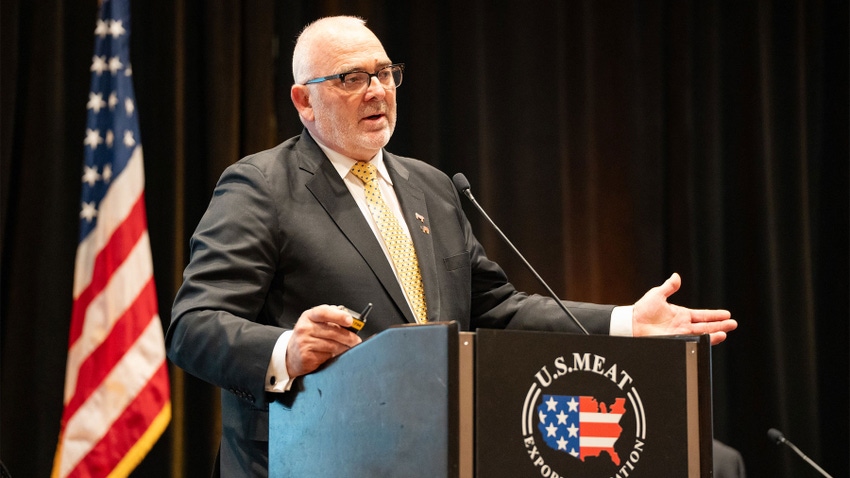
U.S. Meat Export Federation President and CEO Dan Halstrom speaks of the three C’s — collaboration, communication and cooperation — that are important to work in the export market, to create and maintain relationships globally.
Randy Spronk is adding three D’s to the USMEF mission, after recently being elected as the chairman of the trade association representing meat and livestock producers, as well as allied industries.
Diversify
“We really want to diversify, in addition to Japan, create new markets. Create more markets, for each and every primal or every product that we have,” says Spronk, a crop and hog farmer from Edgerton, Minn., “So that we do have backup plans in case there is any issue with one particular market via logistics or politics.”
Spronk Brothers III consists of Randy and his older brother Gordon; Randy’s son, Seth; and Seth’s wife, Taylor Homann, who is also a veterinarian with the Pipestone System. Gordon’s daughter Courtney and her husband, Tyler, are also in the operation. Randy is a member of a group of producers who purchased a former Hormel plant in Fremont, Neb., and is marketing pork products under the label of Wholestone Foods. He has also served as president of the National Pork Producers Council and the Minnesota Pork Producers Association.
Differentiate
“I think that we really have an opportunity, and it’s, how do we differentiate? What is it about our products in the United States that sets us apart from our competitors as we go to market in foreign countries?”
So, what does set U.S meat apart from competitors in the global market?
“It’s really our nutrition, it’s our feed,” Spronk says. “In other words, we’re not importing our feed, we’re raising it in the United States. … It really goes back to the buzzword of sustainability, but it’s how that crop is raised. What kind of tillage practices, what kind of cover crop, what’s their fertility management? There’s a story there that we have because of our inherent production of feed that we have a different story that can lower our carbon footprint can be more sustainable from our competitors. So that’s the story we need to get out there. Of course, whether it’s beef, pork and lamb, we all have feed for corn and soybeans that’s raised in the United States.”
Demand
USMEF, based in Denver, has offices and representatives in 19 locations around the globe, from Seoul, South Korea; to Shanghai; to Monterrey, Mexico, all with the intent of creating demand for U.S. beef, pork and lamb in international markets.
Spronk’s first international trade trip was to Tokyo in 1999 with then-Minnesota Gov. Jesse Ventura. “We were a net importer of pork in the U.S.,” he says, “so to see the growth of the exports of beef, pork and lamb has been phenomenal.”
Staying with that pork example, in 2022, 2.67 million metric tons of U.S. pork and pork variety meats were exported, in value to the tune of $7.68 billion.
With that increased global demand for U.S. meats, has also come a diversified market. “Our top 10 countries are 90% of our exports,” he says. “It’s really important to stop and talk about how we got to that point. … Let’s talk free-trade agreements, it goes back to 2012 with Colombia, South Korea, Panama, CAFTA [Central America Free Trade Agreement].”
Now that those are in full force, “we have lowered tariffs, eliminated non-tariff trade barriers,” he says.
Consumption is key, and Spronk points to Colombia as a success where pounds per capita consumption has doubled, and with a greater value product heading into that country. As well as in Korea, where there are 50 million people and 25 million in the greater Seoul area, “you see the efforts of those free trade agreements, and actually they want more. They’re asking for fresh products. We’ve got fresh product going into Japan, but because of the value of our plants on shelf life, you know, can we get fresh pork into Korea, which is more value that will return more value back to the farm?”
Adding a fourth D to Spronk’s mantra: How do livestock producers fight from becoming discouraged?
“I think most producers are positive. We always look forward,” he says. “Even right now with the swine industry, obviously it’s our cost of production and our revenue. There’s a Delta there that we’re not getting enough revenue for, what our cost of production is; you can look forward into 2024 and have some optimism.”
Some of that optimism originates from another’s pessimism. The European Union’s sow herd is on the decline due to environmental regulation and “some of the cost structures they’ve got there,” Spronk says. “It’s not just single-digit reduction, but it’s double-digit reductions for their sow herd that we think they’re there to last. Well, if they’re not exporting product, and they’ve been our main competitor, that will that hopefully open up some opportunity for us to gain some market share and gain some revenue, more margins.”
About the Author(s)
You May Also Like






